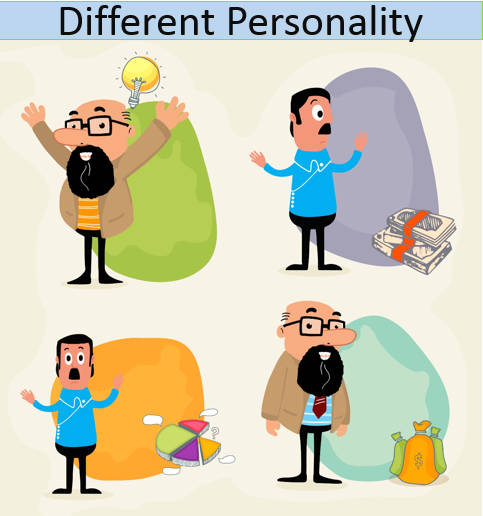Whilst we all come in different shapes, sizes and colors, people are not as different from each other as most of us would like to think. Psychologists for example, have found that human behavior is actually quite easy to predict once you are able to establish what type of personality a person has.
A personality type simply refers to the type of person that you are, such as how you think and what you are likely to do in a particular situation.
Understanding the different types of personalities can therefore help you to better understand people, which in turn, will allow you to communicate more effectively with them.
Some of the other benefits that can come from knowing a person’s personality type include:
- Presenting information in a way that will be best understood.
- Identifying how a person makes decisions.
- Identifying likely patterns of behavior/responses.
- Quickly establishing rapport.
- Improved quality of relationships with others.
Most of the things that you do in life will involve interacting with other people in one way or another. Therefore, the better that you are able to do this, the more successful your life is likely to become.

For example, on a social level, knowing what a certain type of person likes to do or talk about can enable you to get along with them better and develop a friendship faster.
On a professional level, being able to establish such rapport could allow you to communicate with your customers more effectively and possibly even increase your sales levels as a result.
One of the ways that you can gain a better understanding of people, is through an understanding of psychological measures that have been designed to assess and categorize personality types. In this article, we shall be focusing on one of these measures called the Myers-Briggs Type Indicator.
The Myers-Briggs Personality Types
Below is a well know method for assessing personality types. Formally it is called the Myers-Briggs Type Indicator (MBTI) or the Myers-Briggs Personality Scale (MBPS), and assesses personalities based on four scales (see video above for a good quick summary):
- How and where we get our energy from (E) Extrovert – (I) Introvert.
- What type of information we pay attention to (S) Sensor – (N) Intuitive.
- How we make decisions (T) Thinker – (F) Feeler.
- How we resolve issues (J) Judger – (P) Perceiver.
This scale of personality traits was first used in psychological research. However, the information obtained proved to be so useful that it was quickly adopted by advertising agencies in order to tailor advertisements to specific subsections of the population.
Each scale is subdivided into two choices called preferences. Most people will have an overall bias towards one preference. For example, I may be an extrovert whilst you may be an introvert.
People who have an oppositional bias for each scale tend to be very different from each other in terms of their overall character. For example, the personality characteristics displayed by an extroverted person are likely to be very different from the characteristics displayed by an introverted person.
In general, the greater the dissimilarity between two people the more different they will be and the less chance of them being able to get on well together. An easy way to remember this is that people like people who are like themselves.

If you are trying to persuade someone to your way of thinking, you should therefore try to adopt a personality that is similar to the person who you are trying to persuade.
When the four scales are taken as a whole, each preference combines to create 16 possible combinations of personality types. Each personality type uses the first letter from each preference as an abbreviation.
- How and where we get our energy from (E) Extrovert – (I) Introvert.
- What type of information we pay attention to (S) Sensor – (N) Intuitive.
- How we make decisions (T) Thinker – (F) Feeler.
- How we resolve issues (J) Judger – (P) Perceiver.
These lead to the following 16 personality types:
ISTJ ISFJ INFJ INTJ
ISTP ISFP INFP INTP
ESTP ESFP ENFP ENTP
ESTJ ESFJ ENFJ ENTJ
More detailed information about each of these personality types can be found here.
Although these probably don’t mean very much to you right now, they should start to make more sense as we look at each scale in more detail. So let’s do that right now.
1) Where You Get Your Energy From
The first scale measures how a person is energized, and this can vary depending on whether you are a predominantly extroverted or introverted person.
Extrovert Personality

Extroverts get their energy from external sources, such as the company of other people. When they are feeling low, they like to recharge their batteries by mixing with friends and colleagues.
Extroverts like to communicate by thinking and working through a problem out loud. They like to talk things through with others, and enjoy group activities such as team sports.
Because they like being around other people, extroverts feel comfortable in social situations and so usually make good leaders.
Dominant personality characteristics:
- Think aloud.
- Communicate enthusiastically.
- Are talkative.
- Dominate conversation.
- Share personal facts more readily.
- Prefer face-to-face meetings.
- Speak rapidly when giving information.
- Are at ease communicating with groups.
Introvert Personality

Introverts gain their energy through quite solitude. These people may not necessarily dislike the company of others, but feel more comfortable being by themselves and reflecting alone.
Introverts also prefer to work alone, and like to think things through in their head or on paper rather than asking for help from other people.
When it comes to sport, introverts prefer solo sporting activities such as climbing, tennis, swimming or golf. However, these activities are not solely confined to introverts as they may also be enjoyed by extroverts.
Introverts strongly value privacy and time when they can be alone. During these times it is not uncommon for them to read, write or meditate.
Generally speaking, introverts tend to be very intelligent and thoughtful people, although they may suffer from low self-esteem and lack social skills to some degree.
At the moment, it is estimated that around 75% of people are extroverts. This is largely due to the popularization of celebrity culture, and the desire for the attention that goes with it.

However, the popularization of video games and home entertainment has seen a sharp increase in the number of introverts, especially male introverts. Although at the moment, this does not seem to affect women who are predominantly extroverts.
Dominant personality characteristics:
- Reflect, then talk.
- Keep feelings to themselves.
- Listen more than talk.
- Need to be drawn out.
- Keep personal information private.
- Like written memos and reports.
- Pause when answering questions.
- Like to communicate on a one-on-one basis.
2) What Information You Pay Attention To
The second personality scale describes the way you prefer to receive information, and this can vary depending on whether you are a sensor or an intuitive.
Sensor Personality

Sensors tend to pay attention to facts and details, relying on information that is practical and useful. Sensors therefore appreciate an understanding of why something works, especially if it is backed up by scientific or other credible sources of information.
Sensors are also very focused on the present, and what is happening to them right now. Consequently, they tend to prefer satisfying their needs via immediate gratification having a “live for today” attitude.
When making judgments, sensors like to process information via their five senses: sound, taste, touch, smell and sight. This means that they are best convinced when they physically do and experience something firsthand.
Dominant personality characteristics:
- Presents facts and evidence.
- Asks lots of “what” and “how” questions.
- Uses specific examples.
- Is interested in short-term practical applications.
- Likes step-by-step information and detailed descriptions.
- Values real-life experiences.
Intuitive Personality

Intuitives tend to focus on the longer term perspective and the future implications of activities they engage in. Intuitives therefore tend to discipline themselves by not gratifying their needs until a later date (delayed gratification).
When processing information intuitives prefer to see the whole picture first, and then get the finer details later. If sensors see the trees, then intuitives see the forest. As a result, intuitives learn best through general concepts and simplified points or summaries.
Unlike the sensors who prefer to absorb information through their senses, intuitives prefer to go on a gut feeling, trusting their own thoughts and intuition to guide them.
About 65% of the population are categorized as sensors, the rest are intuitive, most of whom are women.
Dominant personality characteristics:
- Presents the “big picture” first.
- Ask lots of ”why” questions.
- Talks about general concepts.
- Is interested in the long-term picture and future possibilities.
- Likes using metaphors and analogies.
- Is interested in personal hunches.
3) How You Make Decisions
The third personality scale measures how you make decisions and come to conclusions, and this can vary depending on whether you are a thinker or a feeler.
Thinker Personality

When it comes to making decisions, thinkers are driven by facts, logic and reason.Thinkers like to look at the evidence, and then weigh up the pros and cons before making a decision or judgment.
Thinkers therefore go and do with what the facts tell them, even if they don’t like what they have discovered. As a result, thinkers tend to be very rational individuals with an extremely open mind. Overall, thinkers strongly value the truth above anything else.
Dominant personality characteristics:
- Uses cold, hard facts and logic to persuade others.
- Like to discuss goals and objectives first before starting anything.
- Weighs up the pros and cons.
- Demonstrates objectivity and critical thinking.
- Believes feelings are only valid if they are logical.
- Are task-focused.
Feeler Personality

If thinkers could be described as head over heart, then feelers could be described as heart over head. When making a decision, feelers tend to be driven by their own emotions and the feelings of others who will be affected by their actions.
For the feelers, all feelings are important and decisions are made based on these feelings in addition to any facts they may have. As a result, feelers tend to be more persuaded by emotional appeals, unlike the thinker who prefers persuasion via facts and evidence.
There is roughly a 50/50 split in the population between thinkers and feelers.
Dominant personality characteristics:
- Persuades others with personal, emotionally presented examples.
- Starts with pleasantries and likes to highlight areas of agreement.
- Considers the value of alternative options.
- Can empathize with and appreciate other viewpoints.
- Believes all feelings are valid.
- Is relationship focused.
4) How You Resolve Issues
This personality scale describes how you like to plan and organize your life, which can vary depending on whether you are a judger or a perceiver.
Judger Personality

Judgers prefer to make decisions quickly. They like to be decisive, and have a clear plan of action to get things done in a timely manner. Uncertainty and indecision tend to frustrate the judger.
Judgers like to be in control and have no problem stepping into a situation and taking charge of it. This makes them natural leaders. Judgers also tend to be very organized, time conscious and are able to work well under pressure.
Dominant personality characteristics:
- Prefer to make decisions quickly and like to be seen as decisive.
- Like to set schedules and deadlines.
- Like to complete projects.
- Negotiate from fixed positions and are sometimes dogmatic.
- Focus discussions on content.
- Like meetings to reach a conclusion.
- Believe time is a fixed resource and deadlines are important.
Perceiver Personality

Perceivers prefer to hold off making decisions until they absolutely have to make them. They prefer to keep their options open, and take their time picking the best option that’s right for them.
Perceivers therefore work best when they can be flexible with time, and are not rushed or put under pressure. As a result, they don’t mind following a leader who will make decisions for them.
Unlike the judger, the perceiver tends not to be very organized and likes to do things in their own leisurely style.
Judgers make up about 60% of the population.
Dominant personality characteristics:
- Likes to keep options open and may procrastinate.
- Feels restricted by schedules and deadlines.
- Prefers to start projects rather than complete them.
- Is flexible about positions and can sometimes be seen as “wishy-washy”.
- Focuses discussions on process.
- Is happy for meetings to remain inconclusive.
- Believes time is renewable and deadlines are elastic.
Summary Of The Four Personality Scales
Below is a quick summary of each of the four Meyers-Briggs personality scales:
Energized by:
Extroverts: Talk first, think later.
Introverts: Reflect silently before talking.
Pay attention to:
Sensors: Want details and specifics.
Intuitives: See the big picture.
Make decisions by:
Thinkers: Weigh facts and evidence.
Feelers: Value emotions and feelings.
Resolve issues by:
Judgers: Decide quickly.
Perceivers: Keep options open.
Videos
The following videos provide some very useful information on the four scales that we have just reviewed. Although the audio isn’t great on them, you may find the videos helpful if you require more detailed information than what has been provided.
Scale 1 – Energized By
Scale 2 – Pay Attention To
Scales 3&4 – Make Decisions/Resolve Issues By
Now that you are familiar with the scales of the Myers-Briggs type indicator, let’s have a look at how they can be used to make you a more persuasive person.
Persuading Different Personalities
Now that you are aware of the different types of personality traits that a person can have, the next step is to use that information in order to make you a more persuasive person.
With practice, this information can help you to communicate more effectively with others and increase your chances of getting someone to do what you want them to.

If you want to persuade someone around to your way of thinking, then you first need to know what type of person you are dealing with. Here are some questions that you can ask to discover their personality type:
1) Are they an introvert or extrovert?
Does the person I want to persuade usually prefer to talk about an issue out loud before acting (extrovert personality), or prefer to reflect on a problem before talking and acting (introvert personality)?
2) Do they prefer details or the general gist?
Does the person I want to persuade pay attention to specific and detailed information (sensor personality), or respond to the global or big picture (intuitive personality)?
3) Do they want facts or do they care more about feelings?
When making a decision does the person I want to persuade base a decision on the quality of facts and evidence (thinker personality), or consider the impact on people’s values and feelings (feeler personality)?
4) Do they want to make a decision now or later?
Does the person I want to persuade prefer to proceed quickly once a decision has been made (judger personality), or prefer to keep their options open (perceiver personality)?

As a persuader, you are not going to know the personality type of everyone you meet. Therefore, rather than trying to persuade someone immediately, it is far wiser to carefully observe a person and look for any clues which may suggest what type of personality they have.
This can be done by asking carefully crafted questions related to the questions that were just listed above, and then listening closely to what that person says. A big mistake many people make is trying to persuade too soon, before ascertaining the personality type.
So play detective, and make sure that you have enough evidence to suggest a personality type before you start trying to persuade them. Remember, because people have different personality types different people will be persuaded in different ways, so you are unlikely to be successful until you know which way that is.
Strategies For Persuasion
Once you have identified a personality type, there are certain strategies that you can use. Here is a reminder of the scales and their preferences.
- How and where we get our energy from (E) Extrovert – (I) Introvert
- What type of information we pay attention to (S) Sensor – (N) Intuitive
- How we make decisions (T) Thinker – (F) Feeler
- How we resolve issues (J) Judger – (P) Perceiver
On a social level the most important scale to consider is first scale, where a person gets their energy from. For example, if you wanted to do something with your partner then it would be a good idea to determine whether they have an extroverted or introverted personality.
If they are an extrovert, then you may want to choose activities which involve being around lots of other people. Such as going to a nightclub, a restaurant or a sporting event.
If your partner is an introvert, then you may want to choose something a bit more intimate, such as a quite night in together watching a movie or having a picnic on a field together.

The fourth scale, how a person resolves issues, is most useful when making deals, coming to conclusions or during disagreements.
A judger personality for example, will appreciate working from a schedule and coming to a firm conclusion or final outcome at the end of the day.
A perceiver on the other hand, would appreciate more flexibility in their work schedule and would like to make decisions that are flexible enough to be changed at a later date if required.

It is important to remember that although people tend to have an overall preference for each scale (e.g. introvert or extrovert) they are rarely solely confined to that preference.
What this means is that although a person may predominantly be an introvert, they may also be a bit of an extrovert in certain situations. So keep this in mind when picking your influence strategies, and be prepared to be flexible.
The four persuasions
When it comes to persuasion, what you really need to concentrate on are the two middle personality scales: What type of information a person pays attention to and how that person makes decisions.
(S) Sensor – (N) Intuitive
(T) Thinker – (F) Feeler
When you narrow it down to these two scales, you will find that there are only four possible personality type combinations:
ST, SF, NT and NF
By focusing on just these four combinations, you come up with four key influencing strategies. To be effective, choose one of these options.
ST
Concentrate on the evidence, and present a step by step logical analysis. Focus on the evidence.
SF
Concentrate on the details, and show how these details will affect the people involved. Focus on the relationship.
NT
Present an overview first, and offer a series of well analyzed practical options. Focus on the logical possibilities.
NF
Present the big picture, and demonstrate how your proposal will impact people’s lives, values and feelings. Help the other person realize their vision.
Concluding remarks
As a final note, please remember that people with the same or similar personality types tend to get on well together, establish rapport quickly and communicate well.
But the more different your personality types are, the longer it will take to establish rapport and the more difficult it will be to communicate effectively.

It is therefore in your best interest as a persuader to identify a person’s personality type, and then to “adapt” yourself to be more like the person you are trying to persuade/influence.
If you would like more information on personality types, please see this website.
Reviewed – 28th March 2016
